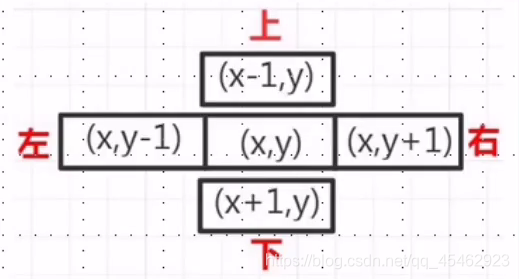题目:
从起点走向终点至少需要多少步(黄色为墙,不可走,每个节点只能走一次)

第一行为 n * m的地图规格接下来是m行地图数据,最后一行的头俩位是起始位置,尾俩位是终点位置;
输入样例:
5 4
1 1 2 1
1 1 1 1
1 1 2 1
1 2 1 1
1 1 1 2
1 1 4 3
输出样例:
7
题解:
数据结构:队列
节点结构:
struct node {
int x; //x轴
int y; //y轴
int step; //走到此节点的步数
};
queue<node> q; //队列初始操作:
1.定义v二维数组用于存放节点是否被访问(0未被访问,1被访问),定义a二维数组用于存放地图(1为路可走,2为墙不走)
int v[100][100], a[100][100];2.输入数据
int n, m;
cin >> n >> m;
for (int i = 1; i <= n; i++) //输入地图
for (int j = 1; j <= m; j++)
cin >> a[i][j];
int startX, startY, pX, pY;
cin >> startX >> startY >> pX >> pY; //起始位置 终点位置3.将起点位置存入队首
node start; //起点节点
start.x = startX; //设置起点的X轴
start.y = startY; //设置起点的Y轴
start.step = 0; //初始化步数为0
q.push(start); //存入队列
v[startX][startY] = 1; //设置此位置已被访问循环操作(模拟走迷宫):
1.取出队首的x轴,y轴,步数
int x = q.front().x;
int y = q.front().y;
int step = q.front().step;2.判断当前队首的x轴与y轴是否等于终点的x轴与y轴
1)等于:找到终点,打印步数,退出循环
1)不等于:继续执行
if (x == pX && y == pY) { //找到终点
cout << step << endl;
break;
}3.遍历当前节点的周边节点是否可访问
周边节点的位置:

int dx[] = {0, 1, 0, -1}; //左右上下
int dy[] = {1, 0, -1, 0}; //左右上下访问条件:1、该节点未被访问 2、该节点不能为墙或不存在
1)可访问:将被访问的节点存入队列,并设置已被访问
1)不可访问:继续执行
for (int i = 0; i <= 3; i++) {
int tx = x + dx[i]; //周边节点的X轴
int ty = y + dy[i]; //周边节点的y轴
if (v[tx][ty] == 0 && a[tx][ty] == 1) { // 1、该节点未被访问 2、该节点不能为墙或不存在
node newNode;
newNode.x = tx;
newNode.y = ty;
newNode.step = step + 1;
q.push(newNode);
v[tx][ty] = 1; //已被访问
}
}4.将当前节点删除
最终代码:
#include <bits/stdc++.h>
using namespace std;
int v[100][100], a[100][100];
struct node {
int x; //x轴
int y; //y轴
int step; //走到此节点的步数
};
queue<node> q;
int main() {
int n, m;
cin >> n >> m;
for (int i = 1; i <= n; i++) //输入地图
for (int j = 1; j <= m; j++)
cin >> a[i][j];
int startX, startY, pX, pY;
cin >> startX >> startY >> pX >> pY;
node start; //起点节点
start.x = startX; //设置起点的X轴
start.y = startY; //设置起点的Y轴
start.step = 0; //初始化步数为0
q.push(start); //存入队列
v[startX][startY] = 1; //设置此位置已被访问
int dx[] = {0, 1, 0, -1}; //左右上下
int dy[] = {1, 0, -1, 0}; //左右上下
while (!q.empty()) {
int x = q.front().x;
int y = q.front().y;
int step = q.front().step;
if (x == pX && y == pY) { //找到终点
cout << step << endl;
break;
}
for (int i = 0; i <= 3; i++) {
int tx = x + dx[i]; //周边节点的X轴
int ty = y + dy[i]; //周边节点的y轴
if (v[tx][ty] == 0 && a[tx][ty] == 1) { //1、该节点未被访问 2、该节点不能为墙或不存在
node newNode;
newNode.x = tx;
newNode.y = ty;
newNode.step = step + 1;
q.push(newNode);
v[tx][ty] = 1; //已被访问
}
}
q.pop();
}
return 0;
}